Nav view search
Navigation
Search
Maha Vir Chakra Awardee List
| Air Cmde | Mehar Singh 1559 GD(P) | Unit : No.1 Op Group | Award Date 26 Jan 50 | Announced 26 Jan 50 | |
| Details : |  Throughout his tenure as A.O.C. No. 1 Group controlling operations in Jammu & Kashmir, Air Commander Mehar Singh displayed great devotion to duty at personal risks and set an example to those serving under him. He was the first pilot to land an aircraft at the emergency landing ground at Poonch and at Leh. These tasks were not part of his duty but in view of the fact that these were hazardous tasks, he was first to carry them out to give confidence to his junior pilots. | ||||
| Reference: | Gazette of India, Extraordinary, Notification No. 2-Pres., dated 26th January, 1950 | ||||
| Wg Cdr | Minoo Merwan Engineer 1614 GD(P) | Unit : 1 Wing | Award Date 26 Jan 50 | Announced 26 Jan 50 | |
| Details : | 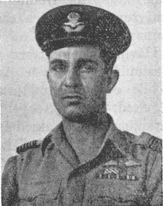 Wing Commander Minoo Merwan Engineer was commissioned as General Duties (Pilot) in the Royal Indian Air Force on 1 August 1940. He was an experienced pilot flying Hurricane fighters in World War II for which he was awarded the DFC in 1945. During Jammu & Kashmir Operations 1947-48, Wing Commander Engineer actively participated in air activity in Kashmir for nearly a year. Under his able guidance the enemy was hit hard on a number of occasions at Kishanganga Bridge, Skardu and Gilgit. During the capture of Gurais the Air Force extended very effective support to the land forces. This was largely due to the drive and initiative shown by Wing Commander Engineer in planning and directing the air operations. Wing Commander Engineer was awarded the Mahavir Chakra for exceptional gallantry and leadership. | ||||
| Reference: | Gazette of India, Extraordinary, Notification No. 2-Pres., dated 26th January, 1950 | ||||
| Sqn Ldr | Sidney Basil Noronha 1735 GD(P) | Unit : No.7 Squadron | Award Date 26 Jan 50 | Announced 26 Jan 50 | |
| Details : | 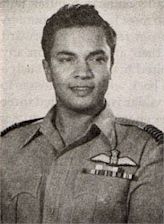 By completing more than 37 operational sorties over enemy’s strong holds in close support of the Indian Army, Wing Commander Norohna has been showing outstanding gallantry. He carried out his Squadron’s offensive role with maximum success in the face of adverse conditions. He has been an outstanding leader both in air and on ground. His brilliant leadership, fearless determination and unswerving devotion to duty have set an inspiring example to all under his command. | ||||
| Reference: | Gazette of India, Extraordinary, Notification No. 2-Pres., dated 26th January, 1950 | ||||
| Wg Cdr | Hrushikesh Moolgavkar 1644 GD(P) | Unit : 1 Wing | Award Date 26 Jan 50 | Announced 08 Dec 51 | |
| Details : | 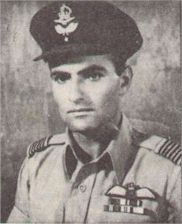 Wing Commander Hrushikesh Moolgavkar commanded No.1 Operational Wing of the IAF in Kashmir from September 1948 to May 1949. Inspite of having to plan out as well as conduct operations from both Jammu and Srinagar, this officer made time to take the air whenver the more difficult and dangerous commitments had to be carried out. In these tasks, he showed great leadership, by his selfless devotion to duty and fearless readiness for offensive action against the enemy. This leaer inspried great confidence in his Squadron commanders and pilots. The air attack on the well defended Domel Bridge and the Uri and Saadabad sectors was led and directed by Wing Commander Moolgavkar personally. When the defences around Uri presented severe obstacles in the way of operational flight on that area, he evolved a plan and attacked the Uri guns in conjuction with one of his Squadron Commanders. This attack not only exposed them to the fire of the anti-aircraft guns but also brought him within the dangerous probability of their aircraft entering the 'Compressibility Zones' with a risky load of bombs at high altitudes. The final link-ups with Poonch, Kargil and Leh were established during the period he was in command of No.1 Operational Wing. The effective support that the IAF was able to render the Army during these operations was in no small measure due to his determination, initiative and drive in planning and coordinating the offensive to success. | ||||
| Reference: | Gazette of India, Notification No. ??/-Press, dated 8th December 1951 | ||||
| Sqn Ldr | Jag Mohan Nath 3946 GD(P) | Unit : No.106 Squadron | Award Date 26 Jan 63 | Announced 26 Jan 63 | |
| Details : | 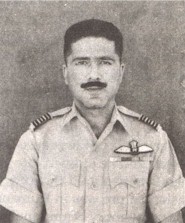 As Flight Commander of an Operational Squadron, Squadron Leader Jag Mohan Nath has fulfilled a number of hazardous operational tasks involving flying over difficult mountain terrain, both by day and by night, in adverse weather conditions and in complete disregard of his personal safety. He has displayed conspicuous gallantry, a very high sense of duty and a high degree of professional skill. As Flight Commander of an Operational Squadron, Squadron Leader Jag Mohan Nath has fulfilled a number of hazardous operational tasks involving flying over difficult mountain terrain, both by day and by night, in adverse weather conditions and in complete disregard of his personal safety. He has displayed conspicuous gallantry, a very high sense of duty and a high degree of professional skill. | ||||
| Reference: | Gazette of India, 16th February 1963 - No. 15-Pres/63., dated 26th January, 1963 | ||||
| Sqn Ldr | Jag Mohan Nath 3946 GD(P) | Unit : No.106 Squadron | Award Date 01 Sep 65 | Announced 01 Sep 65 | |
| Details : |  Bar to MVC During the Indo-Pak War 1965, Sqn Ldr Nath was again the Flight Commander with the Strategic Photo Reconnaissance Squadron flying the Canberra aircraft. He led his unit several times over the hostile territory to obtain vital information about the enemy. The unescorted missions, which were in the nature of reconnaissance, entailed flying long distances over the enemy territory and well-defended airfields and installations during day light. Sqn Ldr Nath was fully aware of the risk he was running on each of these missions. Still, he chose to undertake the risky missions himself. It was after great persuasion that he allowed his colleagues to do some risky assignments. The information gathered by him during his missions proved vitally important to Indian air effort. The missions enabled our Air Force to attack vital enemy targets and this adversely affected enemy's war effort. Sqn Ldr Nath was awarded Bar to Mahavir Chakra for displaying courage, determination and devotion to duty Bar to MVC During the Indo-Pak War 1965, Sqn Ldr Nath was again the Flight Commander with the Strategic Photo Reconnaissance Squadron flying the Canberra aircraft. He led his unit several times over the hostile territory to obtain vital information about the enemy. The unescorted missions, which were in the nature of reconnaissance, entailed flying long distances over the enemy territory and well-defended airfields and installations during day light. Sqn Ldr Nath was fully aware of the risk he was running on each of these missions. Still, he chose to undertake the risky missions himself. It was after great persuasion that he allowed his colleagues to do some risky assignments. The information gathered by him during his missions proved vitally important to Indian air effort. The missions enabled our Air Force to attack vital enemy targets and this adversely affected enemy's war effort. Sqn Ldr Nath was awarded Bar to Mahavir Chakra for displaying courage, determination and devotion to duty | ||||
| Reference: | Gazette of India , 12th February 1966 - No.9 - Pres/65 dated 1st January 1966 | ||||
| Wg Cdr | William MacDonald Goodman 3571 GD(P) | Unit : No.31 Squadron | Award Date 01 Sep 65 | Announced 10 Sep 65 | |
| Details : | 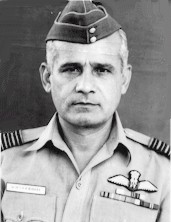 Wing Commander William MacDonald Goodman was commissioned in the Indian Air Force as General Duties (Pilot) on I April 1949. On I September 1965, Pakistan launched a strong armour attack in the Chhamb sector with a view to cut the Indian communication lines to Kashmir. This posed a great threat to Indian security. Wing Commander Goodman, commanding No.31 Squadron flying the Mystere IVa fighter bombers at Pathankot, was entrusted with the task of destroying enemy tanks and troop concentrations in the Chhamb sector. The squadron immediately went into action and blunted the enemy offensive by destroying his tanks and armoured vehicles. Between 2 and 8 September, the squadron undertook many reconnaissance and ground attack missions in the area. These included rocketing of tank concentrations at Troti and Chhamb and strafing of enemy positions at Jaurian. On 9 September the Squadron did the more commendable work. A photo recce and strike mission was undertaken between Kasur and Raiwind by two aircraft. They attacked a train carrying tanks and destroyed twenty of them. This was followed by an attack on a tank and heavy gun concentration at Chawinda. Many of these reconnaissance and ground attack missions were led by Wing Commander Goodman himself in the face of heavy air and ground opposition. He was a source of inspiration to all ranks under his command. Under his guidance the Squadron maintained a very high standard of serviceability which contributed to a number if successful strikes on enemy positions. Wing Commander Goodman was awarded the Maha Vir Chakra for conspicuous gallantry, leadership and professional skill. | ||||
| Reference: | Gazette of India , 1st January 1966 - No.124 - Pres/65 dated 10th September 1965 | ||||
| Wg Cdr | Prem Pal Singh 3871 GD(P) | Unit : No.5 Squadron | Award Date 06 Sep 65 | Announced 10 Sep 65 | |
| Details : | 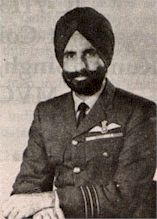 Wing Commander Prem. Pal Singh was commissioned in the Indian Air Force on 15 April 1950. In the beginning he served as a Dakota pilot but later he switched over to the Canberra aircraft Wing Commander Prem. Pal Singh was commissioned in the Indian Air Force on 15 April 1950. In the beginning he served as a Dakota pilot but later he switched over to the Canberra aircraft During the Indo-Pak War 1965, Wing Commander Prem Pal Singh commanded No. 5 "Tuskers" Squadron, stationed at Agra. The unit equipped with the Canberra bomber, was assigned the triple task of tactical bombing, close support and armed patrolling. Under his able guidance the squadron carried out tactical bombing of various targets to destroy the Pakistan Air Force on the ground. Led by Wing Commander Prem Pal Singh himself, Pak army camp east of Gujarat and airfields at Chaklala, Dab, Murid, Akwal, Risalwala, Wagowal, Sargodha and Peshawar were successfully attacked by his bombers. The squadron gave close support to the army in Kasur, Khem Karan, Pasrur, Chawinda and Sialkot sectors. Bombs were dropped on the enemy concentrations at all these places. During the period of war the squadron undertook 39 sorties of armed patrolling over Agra, Palam, Ambala, Halwara and Adampur. Most of the operational missions over the enemy territory were carried out during the hours of darkness. The targets were identified in the moon-light. These dangerous operational sorties were undertaken in the face of heavy enemy anti-aircraft fire with exceptional courage and determination. Wing Commander Prem Pal was awarded the Mahavir Chakra for displaying a high sense of duty and gallantry. | ||||
| Reference: | Gazette of India , 1st January 1966 - No.124 - Pres/65 dated 10th September 1965 | ||||
| Sqn Ldr | Padmanabha Gautam 4482 GD(P) | Unit : Jet Bomber Conversion Unit | Award Date 06 Sep 65 | Announced 22 Sep 65 | |
| Details : | 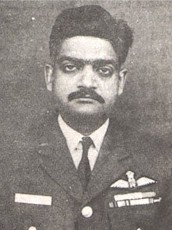 Squadron Leader Padmanabha Gautam was commissioned in the Indian Air Force on 1 April 1953. Squadron Leader Gautam had already seen action in the Congo Operations flying the Canberra bomber of No.5 "Tuskers" Squadron in support of the United Nations Ground Troops. Squadron Leader Gautam was awarded the Vayu Sena Medal for his role in the Congo Operations. Squadron Leader Padmanabha Gautam was commissioned in the Indian Air Force on 1 April 1953. Squadron Leader Gautam had already seen action in the Congo Operations flying the Canberra bomber of No.5 "Tuskers" Squadron in support of the United Nations Ground Troops. Squadron Leader Gautam was awarded the Vayu Sena Medal for his role in the Congo Operations.
During the Indo-Pak War 1965, Squadron Leader Gautam was commanding the Jet Bomber Conversion Unit (JBCU) flying Canberra bombers at Agra. On the outbreak of the hostilities he was assigned many difficult and dangerous missions into enemy territory at short notice. He undertook six offensive, tactical and close support missions deep into enemy territory between 6 and 21 September 1965, notwithstanding the heavy ground fire and Pak Sabre jet attacks. These missions included reconnaissance into enemy territory, bombing of Akwal and Gujarat airfields and strafing of enemy concentrations in Gujarat and Chawinda areas. For displaying exceptional courage, determination and devotion to duty he was decorated with Maha Vir Chakra. | ||||
| Reference: | Gazette of India , 1st January 1966 - No.126 - Pres/65 dated 22nd September 1965 | ||||
| Wg Cdr | Ramesh Sakharam Benegal 4220 F(P) | Unit : No.106 Squadron | Award Date 17 Dec 71 | Announced 18 Dec 71 | |
| Details : | 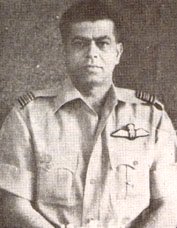 As the Officer Commanding of an Operational reconnaissance squadron [No.106 SR Squadron, Canberras] he has carried out a very large number of missions over enemy territory and has obtained vital information about enemy Air Force and other installations. These missions have entailed flying unarmed and unescorted vary deep into enemy territory and to heavily defended targets. The information brought back from these missions has facilitated the planning of Army, Air Force and Naval operations and has thus directly contributed to the attrition of the Pakistani war machine, It is further to the credit of Wing Commander Benegal that he has never returned from any of these innumerable missions without having achieved his object in full measure. While flying repeatedly deep into enemy territory in an unarmed aircraft he has displayed gallantry, devotion to duty and professional skill of the highest order. As the Officer Commanding of an Operational reconnaissance squadron [No.106 SR Squadron, Canberras] he has carried out a very large number of missions over enemy territory and has obtained vital information about enemy Air Force and other installations. These missions have entailed flying unarmed and unescorted vary deep into enemy territory and to heavily defended targets. The information brought back from these missions has facilitated the planning of Army, Air Force and Naval operations and has thus directly contributed to the attrition of the Pakistani war machine, It is further to the credit of Wing Commander Benegal that he has never returned from any of these innumerable missions without having achieved his object in full measure. While flying repeatedly deep into enemy territory in an unarmed aircraft he has displayed gallantry, devotion to duty and professional skill of the highest order. | ||||
| Reference: | Gazette of India , 12th February 1972 - No.20 - Pres/72 dated 20th January 1972 | ||||
| Wg Cdr | Vidya Bhushan Vasisht 4584 F(P) | Unit : No.44 Squadron | Award Date 03 Dec 71 | Announced 18 Dec 71 | |
| Details : | 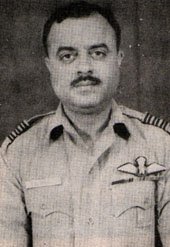 Wing Commander Vasisht, the Commanding Officer of an operational squadron [No.44 Squadron, Antonov An-12] , led a group of heavy bombers of his squadron to attack an important enemy fuel and ammunition dump at Changa Manga forest on the night of December 3. 1971. In spite of very heavy enemy ground fire. the pressed home the attack, and caused severe damage to the target. Again, on the next night, he led another raid to the same target and succeeded in causing further heavy damage in the face of intense enemy ground fire. On the night of December 5, 1971, he led a formation of his bombers, this time to attack enemy positions in the Haji Pir Pass in Pakistan-occupied Kashmir. The difficulties and dangers of this operation were due as much to the great volume of ground fire in the target area, as to the hazards of flying his large aircraft and leading his formation at low level through mountainous terrain. In spite of these hazards. Wing Commander Vasisht pressed home tha attack and achieved marked success in hitting the enemy's positions. In addition to these, he had led many other missions deep into enemy territory where opposition could be expected from fighter aircraft and anti-aircraft fire. In all these raids Wing Commander Vasisht completed the tasks to him without any loss to our aircraft. He has displayed inspired leadership, exceptional devotion to duly, and conspicuous bravery in repeatedly leading attacks against heavily defended enemy targets, night after night. Wing Commander Vasisht, the Commanding Officer of an operational squadron [No.44 Squadron, Antonov An-12] , led a group of heavy bombers of his squadron to attack an important enemy fuel and ammunition dump at Changa Manga forest on the night of December 3. 1971. In spite of very heavy enemy ground fire. the pressed home the attack, and caused severe damage to the target. Again, on the next night, he led another raid to the same target and succeeded in causing further heavy damage in the face of intense enemy ground fire. On the night of December 5, 1971, he led a formation of his bombers, this time to attack enemy positions in the Haji Pir Pass in Pakistan-occupied Kashmir. The difficulties and dangers of this operation were due as much to the great volume of ground fire in the target area, as to the hazards of flying his large aircraft and leading his formation at low level through mountainous terrain. In spite of these hazards. Wing Commander Vasisht pressed home tha attack and achieved marked success in hitting the enemy's positions. In addition to these, he had led many other missions deep into enemy territory where opposition could be expected from fighter aircraft and anti-aircraft fire. In all these raids Wing Commander Vasisht completed the tasks to him without any loss to our aircraft. He has displayed inspired leadership, exceptional devotion to duly, and conspicuous bravery in repeatedly leading attacks against heavily defended enemy targets, night after night. | ||||
| Reference: | Gazette of India , 12th February 1972 - No.20 - Pres/72 dated 20th January 1972 | ||||
| Wg Cdr | Harcharan Singh Manget 4666 F(P) | Unit : No.32 Squadron | Award Date 04 Dec 71 | Announced 18 Dec 71 | |
| Details : | 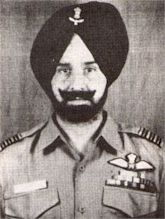 As the Commanding Officer of a fighter bomber squadron [No.32 Squadron, Sukhoi-7] he has undertaken a number of interdiction and close support missions and also many photographic reconnaissance sorties, without fighter escort, deep into enemy territory. The information brought by him from the reconnaissance sorties has been of great value to the Army and the Air Force in their operational planning. While on a strike mission his aircraft was hit thrice by intense anti-aircraft fire but he pressed forward until he found that the other aircraft in his formation had also suffered serious damage. At this point enemy interceptors came on the scene. Despite this, he extricated his formation from the hazardous situation and led it safely back to base. On landing it was found that his aircraft was extensively damaged and major portions of the control surfaces completely shot away. Only superb flying skill and courage of the highest order could have brought such a badly damaged aircraft back to a safe landing. His leadership of the mission in those circumstances was outstanding. He has displayed gallantry determination and professional skill of the highest order. As the Commanding Officer of a fighter bomber squadron [No.32 Squadron, Sukhoi-7] he has undertaken a number of interdiction and close support missions and also many photographic reconnaissance sorties, without fighter escort, deep into enemy territory. The information brought by him from the reconnaissance sorties has been of great value to the Army and the Air Force in their operational planning. While on a strike mission his aircraft was hit thrice by intense anti-aircraft fire but he pressed forward until he found that the other aircraft in his formation had also suffered serious damage. At this point enemy interceptors came on the scene. Despite this, he extricated his formation from the hazardous situation and led it safely back to base. On landing it was found that his aircraft was extensively damaged and major portions of the control surfaces completely shot away. Only superb flying skill and courage of the highest order could have brought such a badly damaged aircraft back to a safe landing. His leadership of the mission in those circumstances was outstanding. He has displayed gallantry determination and professional skill of the highest order. | ||||
| Reference: | Gazette of India , 12th February 1972 - No.20 - Pres/72 dated 20th January 1972 | ||||
| Sqn Ldr | Madhabendra Banerji 4898 F(P) | Unit : No.101 Squadron | Award Date 17 Dec 71 | Announced 18 Dec 71 | |
| Details : | 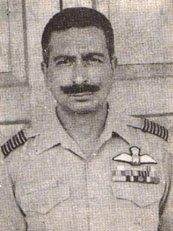 Squadron Leader Banerji, a senior pilot in a fighter bomber squadron [No101 Squadron, Sukhoi-7], led no fewer than 14 missions in S-22 aircraft within the first week of the present war against enemy targets, most of them in support of our Army in the Chhamb battles. During these missions, he destroyed two enemy tanks and two guns. On three occasions, he was personally responsible for attacking the enemy in the face of heavy ground fire, thus relieving pressure on our own troops. He has displayed bravery and skill in repeatedly returning to the fray in the face of extremely heavy ground fire. Squadron Leader Banerji, a senior pilot in a fighter bomber squadron [No101 Squadron, Sukhoi-7], led no fewer than 14 missions in S-22 aircraft within the first week of the present war against enemy targets, most of them in support of our Army in the Chhamb battles. During these missions, he destroyed two enemy tanks and two guns. On three occasions, he was personally responsible for attacking the enemy in the face of heavy ground fire, thus relieving pressure on our own troops. He has displayed bravery and skill in repeatedly returning to the fray in the face of extremely heavy ground fire. | ||||
| Reference: | Gazette of India , 12th February 1972 - No.20 - Pres/72 dated 20th January 1972 | ||||
| Wg Cdr | Cecil Vivian Parker 4346 F(P) | Unit : No.20 Squadron | Award Date 04 Dec 71 | Announced 26 Jan 72 | |
| Details : | 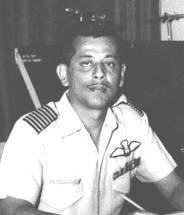 Wing Commander Parker. the Officer Commanding to a fighter bomber squadron [No.20 Squadron, Hunters] led many deep penetration missions into enemy held territory attacking strongly defended targets. While returning from one such mission, his formation was attacked by enemy Sabre aircraft In the ensuing tight. Wing Commander Parker shot down one Sabre and heavily damaged another. In another mission, he attacked the enemy oil refinery at Attock, in the face of the most intense anti-aircraft and small arms tire. seriously damaging the refinery. In all his missions, the actions of Wing Commander Parker have been marked by great courage and determination, and he has been a shining example to the other pilots under his command. His leadership both in peace and war has been outstanding. He has displayed devotion to duty, bravery in the face of heavy enemy opposition and courage in leading many missions day after day. Wing Commander Parker. the Officer Commanding to a fighter bomber squadron [No.20 Squadron, Hunters] led many deep penetration missions into enemy held territory attacking strongly defended targets. While returning from one such mission, his formation was attacked by enemy Sabre aircraft In the ensuing tight. Wing Commander Parker shot down one Sabre and heavily damaged another. In another mission, he attacked the enemy oil refinery at Attock, in the face of the most intense anti-aircraft and small arms tire. seriously damaging the refinery. In all his missions, the actions of Wing Commander Parker have been marked by great courage and determination, and he has been a shining example to the other pilots under his command. His leadership both in peace and war has been outstanding. He has displayed devotion to duty, bravery in the face of heavy enemy opposition and courage in leading many missions day after day. | ||||
| Reference: | Gazette of India , 12th February 1972 - No.20 - Pres/72 dated 20th January 1972 | ||||
| Sqn Ldr | Ravinder Nath Bharadwaj 5001 F(P) | Unit : No.20 Squadron | Award Date 05 Dec 71 | Announced 26 Jan 72 | |
| Details : | 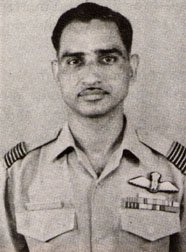 Squadron Leader Bhardwaj, a senior pilot in a fighter-bomber squadron [No.20 Squadron, Hunters] , has led a number of operational missions against a variety of enemy targets. On December 5, 1971, he led a raid on an enemy airfield. Although the target was heavily defended by anti-aircraft and small arms fire, he pressed home the attack. He himself set fire to an enemy heavy transport aircraft in one of his attacks, and eventually led his mission safely back to base. On December 7, 1971 , he led another mission this time to heavily defended power station. Here too, his mission succeeded in causing heavy damage, without any loss to our aircraft. On December 10, 1971, he led a close support mission to the Chhamb area. During the first attack, his aircraft as well as that of his number two were hit by ground fire, and as they pulled out of the attacks they were engaged by enemy Sabres. He guided his number two out of danger, and then returned to the fray shooting down a Sabre which crashed inside our lines near the Chhamb bridge. By this time he was alone, but he returned to the attack, against Pakistani tanks and troops, and caused extensive damage to these targets before nursing his damaged aircraft back to base, where he landed safely. He has displayed exceptional gallantry, leadership and bravery in the face of heavy odds, which are in the highest traditions of the Air Force. Squadron Leader Bhardwaj, a senior pilot in a fighter-bomber squadron [No.20 Squadron, Hunters] , has led a number of operational missions against a variety of enemy targets. On December 5, 1971, he led a raid on an enemy airfield. Although the target was heavily defended by anti-aircraft and small arms fire, he pressed home the attack. He himself set fire to an enemy heavy transport aircraft in one of his attacks, and eventually led his mission safely back to base. On December 7, 1971 , he led another mission this time to heavily defended power station. Here too, his mission succeeded in causing heavy damage, without any loss to our aircraft. On December 10, 1971, he led a close support mission to the Chhamb area. During the first attack, his aircraft as well as that of his number two were hit by ground fire, and as they pulled out of the attacks they were engaged by enemy Sabres. He guided his number two out of danger, and then returned to the fray shooting down a Sabre which crashed inside our lines near the Chhamb bridge. By this time he was alone, but he returned to the attack, against Pakistani tanks and troops, and caused extensive damage to these targets before nursing his damaged aircraft back to base, where he landed safely. He has displayed exceptional gallantry, leadership and bravery in the face of heavy odds, which are in the highest traditions of the Air Force. | ||||
| Reference: | Gazette of India , 12th February 1972 - No.20 - Pres/72 dated 20th January 1972 | ||||
| Wg Cdr | Padmanabha Gautam 4482 F(P) | Unit : No.16 Squadron | Award Date 05 Dec 71 | Announced 26 Jan 72 | |
| Details : |  Wing Commander Padmanabha Gautam, MVC; VM, Commanding Officer of a bomber squadron [No.16 Squadron, Canberras] led many missions deep into enemy territory. Notable among these are two raids on the night of December 5th and 7th, 1971,when he led attacks on Mianwali airfield. On both these occasions he and his formation were met with intense anti-aircraft fire. Despite that, the target was attacked with great precision, at low level, and heavy damage was inflicted. On other missions, Wg Cdr Gautam carried out rocket and four gun attacks on railway marshalling yards in the Montgomery-Raiwind area with conspicuous success. Through out the period of operations, Wg Cdr Gautam displayed an ability for cool and clear planning, along with unflinching courage, exemplar flying skill and leadership of the highest order in carrying out many hazardous missions. His conduct has been in the finest tradition of the Air Force. Wing Commander Padmanabha Gautam, MVC; VM, Commanding Officer of a bomber squadron [No.16 Squadron, Canberras] led many missions deep into enemy territory. Notable among these are two raids on the night of December 5th and 7th, 1971,when he led attacks on Mianwali airfield. On both these occasions he and his formation were met with intense anti-aircraft fire. Despite that, the target was attacked with great precision, at low level, and heavy damage was inflicted. On other missions, Wg Cdr Gautam carried out rocket and four gun attacks on railway marshalling yards in the Montgomery-Raiwind area with conspicuous success. Through out the period of operations, Wg Cdr Gautam displayed an ability for cool and clear planning, along with unflinching courage, exemplar flying skill and leadership of the highest order in carrying out many hazardous missions. His conduct has been in the finest tradition of the Air Force. | ||||
| Reference: | Gazette of India , 12th February 1972 - No.22 - Pres/72 dated 20th January 1972 | ||||
| Wg Cdr | Man Mohan Bir Singh Talwar 4573 F(P) | Unit : No.5 Squadron | Award Date 17 Dec 71 | Announced 26 Jan 72 | |
| Details : | 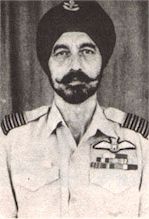 Wing Commander Talwar, Commanding Officer of a Bomber Squadron [No.5 Squadron, Canberras] led five day and night bombing missions against very heavily defended enemy targets within the first 10 days of operations. On one of these missions, he inflicted very severe damage to the Pakistani Air Force installations at Sargodha. In a daylight mission in the Chhamb area, in support of the army, he attacked four enemy gun positions near the Munnawar Tawi river and effectively silenced three of them facilitating the advance of our troops in difficult terrain. Both these targets were heavily defended ; the latter was close to an enemy fighter base from where interception was also likely. Despite this, the officer pressed home his attacks with great determination and much success. His conduct was an inspiration to the crews of the other aircraft which he was leading. The bold leadership, tenacity of purpose, flying skill and bravery displayed by Wing Commander Talwar were largely responsible for the many successes of his squadron. Wing Commander Talwar, Commanding Officer of a Bomber Squadron [No.5 Squadron, Canberras] led five day and night bombing missions against very heavily defended enemy targets within the first 10 days of operations. On one of these missions, he inflicted very severe damage to the Pakistani Air Force installations at Sargodha. In a daylight mission in the Chhamb area, in support of the army, he attacked four enemy gun positions near the Munnawar Tawi river and effectively silenced three of them facilitating the advance of our troops in difficult terrain. Both these targets were heavily defended ; the latter was close to an enemy fighter base from where interception was also likely. Despite this, the officer pressed home his attacks with great determination and much success. His conduct was an inspiration to the crews of the other aircraft which he was leading. The bold leadership, tenacity of purpose, flying skill and bravery displayed by Wing Commander Talwar were largely responsible for the many successes of his squadron. | ||||
| Reference: | Gazette of India , 12th February 1972 - No.20 - Pres/72 dated 20th January 1972 | ||||
| Wg Cdr | Allan Albert D'Costa 4580 F(P) | Unit : No.222 Squadron | Award Date 04 Dec 71 | Announced 26 Jan 72 | |
| Details : | 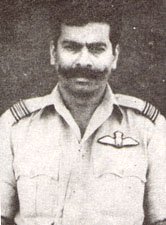 Wing Commander A.A.D'Costa, the Commanding Officer of a Fighter-Bomber squadron [No.222 Squadron, Sukhoi-7], had brought his squadron up to the highest pitch of operational preparedness. His foresight and leadership paid excellent dividends during the war, as he and the Squadron achieved outstanding results. During the war, the officer led no fewer than 15 missions deep into enemy territory against heavily defended targets, thus setting a fine example to his pilots. On December 4,1971 he was the first to strike at the enemy's Risalwala airfield. On the same day he followed up by attacking Chander airfield. On the next day, he led a mission to Chistian Mandi, where he personally accounted for three enemy tanks, as confirmed by films brought back by him. On December 6 he led an attack on a concentration of tanks at Dera Baba Nanak, in the face of the most intense anti-aircraft fire. Although his No. 2 was shot down by this ground fire. he pressed home the attack, with utter disregard for his own safety, destroying a number of tanks and damaging others. On December 7 he carried out a low level photographic reconnaissance mission, in the Sulemanki area and followed this up by leading an attack on the same day, on the railway station at Norowal, where he personally destroyed and damaged many railway wagons, as well as some installations. From December 8 to 12 he flew a number of unescorted reconnaissance missions, bringing back a large volume of intelligence based on which air and ground operations were conducted. Thereafter, up to the end of the fighting, he led missions mainly against railway targets, including the marshalling yards at Raiwind, the Kasur-Lahore railway tracks, destroying a large number of wagons and causing devastation at each target. His constant example of bravery, determination and skill were an inspiration to the pilots of his squadron. Wing Commander A.A.D'Costa, the Commanding Officer of a Fighter-Bomber squadron [No.222 Squadron, Sukhoi-7], had brought his squadron up to the highest pitch of operational preparedness. His foresight and leadership paid excellent dividends during the war, as he and the Squadron achieved outstanding results. During the war, the officer led no fewer than 15 missions deep into enemy territory against heavily defended targets, thus setting a fine example to his pilots. On December 4,1971 he was the first to strike at the enemy's Risalwala airfield. On the same day he followed up by attacking Chander airfield. On the next day, he led a mission to Chistian Mandi, where he personally accounted for three enemy tanks, as confirmed by films brought back by him. On December 6 he led an attack on a concentration of tanks at Dera Baba Nanak, in the face of the most intense anti-aircraft fire. Although his No. 2 was shot down by this ground fire. he pressed home the attack, with utter disregard for his own safety, destroying a number of tanks and damaging others. On December 7 he carried out a low level photographic reconnaissance mission, in the Sulemanki area and followed this up by leading an attack on the same day, on the railway station at Norowal, where he personally destroyed and damaged many railway wagons, as well as some installations. From December 8 to 12 he flew a number of unescorted reconnaissance missions, bringing back a large volume of intelligence based on which air and ground operations were conducted. Thereafter, up to the end of the fighting, he led missions mainly against railway targets, including the marshalling yards at Raiwind, the Kasur-Lahore railway tracks, destroying a large number of wagons and causing devastation at each target. His constant example of bravery, determination and skill were an inspiration to the pilots of his squadron. | ||||
| Reference: | Gazette of India , 12th February 1972 - No.20 - Pres/72 dated 20th January 1972 | ||||
| Wg Cdr | Swaroop Krishna Kaul 4721 F(P) | Unit : No.37 Squadron | Award Date 04 Dec 71 | Announced 26 Jan 72 | |
| Details : |  At the outbreak of hostilities, Wing Commander S K Kaul, the Commanding Officer of a Fighter Bomber Squadron [No.37 Squadron, Hunters], volunteered for an urgent task to photograph certain areas in Bangla Desh. These photographs were badly needed in order to finalise our Army’s assault plans. The officer carried out four missions deep into enemy territories ot cover the heavily defended sectors of Comila, Sylhet and Saidapur. At times, he had to fly as low as 200 feet over the most heavily defended enemy locations. Undaunted, he flew through these barrages, making repeated runs in each of his missions and successfully completed the task. On 4th December 1971, he again volunteered for another task to photograph the Tezgaon and Kurmitola airfields. His reconnaissance flights over these two airfields, in the face of the most sustained and heavy enemy ground fire stood out as acts of heroism, extreme gallantry and devotion to duty. In addition to his reconnaissance exploits, he led the very first eight aircraft strike mission over Dacca. In this raid, his formation encountered four enemy aircraft near the target area. With exemplary leadership, he manoeuvred his forces in such a manner that two of the enemy aircraft could be shot down and the other two fled. The target thus became clear for attack. Throughout the period of operations, Wing Commander Kaul led his squadron boldly, with tenacity and personally displayed courage of an exceptionally high order in the face of the enemy At the outbreak of hostilities, Wing Commander S K Kaul, the Commanding Officer of a Fighter Bomber Squadron [No.37 Squadron, Hunters], volunteered for an urgent task to photograph certain areas in Bangla Desh. These photographs were badly needed in order to finalise our Army’s assault plans. The officer carried out four missions deep into enemy territories ot cover the heavily defended sectors of Comila, Sylhet and Saidapur. At times, he had to fly as low as 200 feet over the most heavily defended enemy locations. Undaunted, he flew through these barrages, making repeated runs in each of his missions and successfully completed the task. On 4th December 1971, he again volunteered for another task to photograph the Tezgaon and Kurmitola airfields. His reconnaissance flights over these two airfields, in the face of the most sustained and heavy enemy ground fire stood out as acts of heroism, extreme gallantry and devotion to duty. In addition to his reconnaissance exploits, he led the very first eight aircraft strike mission over Dacca. In this raid, his formation encountered four enemy aircraft near the target area. With exemplary leadership, he manoeuvred his forces in such a manner that two of the enemy aircraft could be shot down and the other two fled. The target thus became clear for attack. Throughout the period of operations, Wing Commander Kaul led his squadron boldly, with tenacity and personally displayed courage of an exceptionally high order in the face of the enemy | ||||
| Reference: | Gazette of India , 12th February 1972 - No.20 - Pres/72 dated 20th January 1972 | ||||
| Gp Capt | Chandan Singh 3460 F(P) | Unit : 10 Wing | Award Date 07 Dec 71 | Announced 26 Jan 72 | |
| Details : | 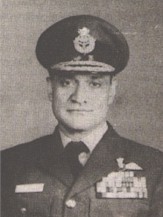 Group Captain Chandan Singh, AVSM. VRC is the officer commanding of an Air Force Station in the East [Air Force Station, Jorhat]. During the war with Pakistan, he was in the forefront of the air operations conducted for the liberation of Bangla Desh. Group Captain Chandan Singh was also responsible for the planning and execution of the special helicopter operations to airlift two companies of troops of the Sylhet area. When it became necessary to overcome the obstacles in the advance of the army towards Dacca, he planned and executed the move of nearly 3,000 troops and 40 tons of equipment and heavy guns with the extremely limited helicopter force at his disposal. This operation entailed landing the troops and equipment near heavily defended areas by night. Prior to each mission he personally carried out reconnaissance in the face of heavy enemy fire. On the night of December 7/8 he flew eight missions, deep into enemy territory to supervise the progress of the helicopter airlift and to guide and inspire his pilots who were facing heavy opposition from ground tire. Later he undertook a further 18 missions in the same operation, always leading the landings at new places. On many occasions his helicopter was hit by ground fire, but this did not deter him from further missions. The success of this major airborne operation contributed significantly to the fall of Dacca and the capitulation of tie Pakistan armed forces, in Bangla Desh. The leadership, drive and determination coupled with the bravery shown by Group Captain Chandan Singh over an extended .period of time, are in the highest traditions of the Air Force. Group Captain Chandan Singh, AVSM. VRC is the officer commanding of an Air Force Station in the East [Air Force Station, Jorhat]. During the war with Pakistan, he was in the forefront of the air operations conducted for the liberation of Bangla Desh. Group Captain Chandan Singh was also responsible for the planning and execution of the special helicopter operations to airlift two companies of troops of the Sylhet area. When it became necessary to overcome the obstacles in the advance of the army towards Dacca, he planned and executed the move of nearly 3,000 troops and 40 tons of equipment and heavy guns with the extremely limited helicopter force at his disposal. This operation entailed landing the troops and equipment near heavily defended areas by night. Prior to each mission he personally carried out reconnaissance in the face of heavy enemy fire. On the night of December 7/8 he flew eight missions, deep into enemy territory to supervise the progress of the helicopter airlift and to guide and inspire his pilots who were facing heavy opposition from ground tire. Later he undertook a further 18 missions in the same operation, always leading the landings at new places. On many occasions his helicopter was hit by ground fire, but this did not deter him from further missions. The success of this major airborne operation contributed significantly to the fall of Dacca and the capitulation of tie Pakistan armed forces, in Bangla Desh. The leadership, drive and determination coupled with the bravery shown by Group Captain Chandan Singh over an extended .period of time, are in the highest traditions of the Air Force. | ||||
| Reference: | Gazette of India , 12th February 1972 - No.20 - Pres/72 dated 20th January 1972 | ||||
| Sqn Ldr | Ajjamada Boppayya Devayya 4810 GD(P) | Unit : No.1 Squadron | Award Date 07 Sep 65 | Announced 26 Jan 88 | |
| Details : |  Sqn Ldr Ajjamada Boppayya Devayya was an instructor with the Air Force Flying College at the outbreak of the war. He was posted to No.1 "Tigers" Squadron at Adampur flying the Mystere IVa fighter bomber. Sqn Ldr Ajjamada Boppayya Devayya was an instructor with the Air Force Flying College at the outbreak of the war. He was posted to No.1 "Tigers" Squadron at Adampur flying the Mystere IVa fighter bomber.
On 7th September 1965, Sqn Ldr Devayya was a part of a formation of aircraft on a strike mission to Sargodha Airfield in Pakistan. He was the last aircraft of the mission to finish the attack and as he was turning away he was intercepted by an enemy F-104 Starfighter aircraft. After Sqn Ldr Devayya successfully evaded the missiles launched by the enemy aircraft, his attacker , flying a faster aircraft caught up with him and fired his guns damaging Sqn Ldr Devayya's aircraft. Sqn Ldr Devayya, displaying true fighting spirit opted for aircombat with the superior enemy aircraft and shot down the attacker. In the process, he made the supreme sacrifice as he probably crashed or was killed. For showing conspicuous gallantry in putting the safety of his colleagues before his own, and In electing to get into an aerial combat with the F-104 even while his own aircraft was damaged, Squadron Leader Devayya displayed Valour of the highest order. Sqn Ldr Devayya was awarded the Maha Vir Chakra Posthumously. Till date the only instance of a Posthumous MVC to the Indian Air Force. | ||||
| Reference: | Gazette of India, 28th April 1988 - No.36-Pres/88 dated 22nd January 1988 | ||||
